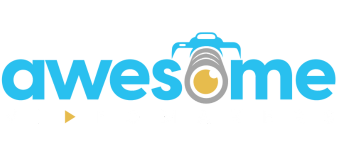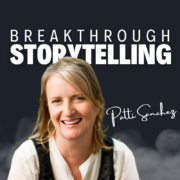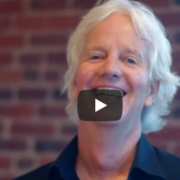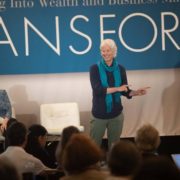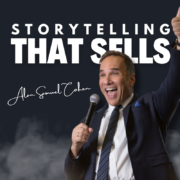149. How to breakthrough the noise with storytelling with Patti Sanchez
Want to go further on how to use Storytelling to stand out & grow your brand? Check out these other episodes:
# 143. How to be more bingeable than Netflix
# 84. How to sell with a story
If you want to amp-up your impact as a communicator, check out this conversation I had with Patti Sanchez about storytelling.
In this episode, Patti unpacks how anyone can (and should) use story to make their messages stand out, whether they’re communicating online or in-person.
She also shares real, practical examples of stories used in everyday communication, as well as what motivated her to become a storyteller herself.
Patti’s a passionate advocate for storytelling because it’s a potent tool for communication and leadership.
Why? Because stories:
- Create emotional appeal that commands attention and compels audiences to lean in.
- Make abstract or complex ideas understandable, relatable, and memorable.
- Build connection, rapport, and trust that deepens relationships.
There’s a reason the world’s most admired brands and beloved leaders tell stories. Listen up to find out how you can put storytelling to work for you, too!
Patti’s a storytelling consultant and author of award-winning books on persuasive communication and change leadership. After 30+ years in advising some of the world’s top brands, she started her own firm to help leaders and their teams harness story-driven communication to drive positive change.
Episode Resources
Whenever you’re ready…
I help business leaders, consultants & coaches create a short-form video sales system that makes selling easy. In a 1-hour remote interview you get 1 month of short form video content that does your selling for you – scheduled across all your social media channels. Imagine having dream clients excited to buy from you because they’ve been pre-sold by your videos.
Transcript
Brad Powell:
Hey, it’s Brad and before we get started, I just wanted to talk a little bit about today’s topic, which is storytelling.
Brad Powell:
And I want to go a little bit meta here because I’ve really been looking for ways that I can stand out more with my own content by using stories.
Brad Powell:
So I just took this really great course by Alex Bloomberg and Alex is the guy who’s produced shows like this, American Life and Planet Money for Public Radio Like he’s one of the best radio audio storytellers on the planet right now and his course was called Power your Podcast with Storytelling and I was thinking I wanna power my podcast with storytelling. So I’ve been looking for ways that I can use story in all of my content, but in particular in this show, and so with today’s guest, given that she’s a storyteller, I was very encouraging for her to tell stories instead of just sharing the information on how to tell stories. And she delivered. She actually tells three separate stories, so you can look out for those and notice how you connect with her and the content that she’s delivering because of the stories that she’s telling. And you can look forward to more stories and stuff about storytelling in this series, because I really think that this is one of the very essential keys to standing out. And with that let’s start the show.
Patti Sanchez:
It’s especially important when you’re trying to build connection with people or you’re trying to build trust and rapport with people. For leaders, for managers, for salespeople, story is a way to create that emotional connection with your audience Because, like you said, we are wired for it. When we hear a story, we actually have hormones released in our body. It kind of chemically bonds us together when we hear a story because we’re feeling all these feelings. So it’s a really powerful way to establish that common ground and that connection with people. Tell a story because you’re going to create a deeper connection with people than just your words can do alone.
Brad Powell:
Welcome to the Standout Business Show, where it’s all about making a bigger difference by doing business differently. I’m Brad Powell and here’s my question today Do you find yourself struggling to cut through all the noise and truly engage with your audience? Do you want to build more authentic connections with people, even though you are meeting with them virtually? Here’s the thing Communicating to audiences remotely has become this essential skill because the future of work is mostly happening online, which means that you’ve got to become a real professional at virtual presenting and using storytelling in your messaging, because stories are sticky. Using stories is going to help you people remember what you have to say, which is why you want to listen to today’s guest, patti Sanchez. Patti is a storytelling consultant. She’s the author of award-winning books on persuasive communication and change leadership and, after 30 years in advising some of the world’s top brands, she started her own firm to help leaders and their teams harness story-driven communication to drive positive change. Stay tuned. Communication to drive positive change Stay tuned.
Brad Powell:
So today’s topic is going to be all about storytelling, but just listening to another episode on storytelling isn’t going to make you stand out or be a great storyteller on its own. You know what’s going to make you stand out Actually putting your face to your brand and showing up on video and I know what you’re thinking. You don’t have the time to spend making videos, editing videos and posting videos all over social media, which is why I created my Done For you Mic Drop Moments program. When we work together, you’ll spend just one hour each month with me, where you’ll sit for a remote interview. I’ll ask you questions, I’ll pull out your best insights, then I’ll edit your footage into a month’s worth of short-form video that gets posted to all your social media channels. You spend just one hour with me and you get a month of video content.
Brad Powell:
That’s building trust and connection with your ideal audience, 24 hours a day, seven days a week. If you want to learn more, then schedule a standout video call with me, where I’ll help you see how you can start building trust and authority and start earning bigger clients by being more yourself on video. Look for the link in the description or go to mymicdropmomentscom. And now back to the show. All right, and we are back. Patty, welcome to the show.
Patti Sanchez:
Thanks for having me.
Brad Powell:
And so to get started, I actually want to start at a point where you tell me the story of when and how you realized that storytelling was so core to the way that we need to communicate.
Patti Sanchez:
Oh, I was a youngin’, I was in high school and you remember assemblies.
Brad Powell:
Did you?
Patti Sanchez:
ever go to assemblies. Right, Everybody files in.
Brad Powell:
Unfortunately I do remember assembly.
Patti Sanchez:
Yeah, they were painful, most of the time right, or at least really boring. But on this case, this occasion, we all filed into this auditorium and there was a speaker who was going to talk to us and he was actually an ex-con. It was sort of like a scared straight situation and what he did was, instead of having some kind of pre-written speech, he just told stories. He talked about his life experience and the struggles that he encountered and the problems that he went through and why he knew that he needed to get out and tell his story to kids, because he made a lot of bad choices when he was a teenager and he didn’t want other teenagers to do that.
Patti Sanchez:
And I remember sitting on my hard little plastic seat in the gym listening to him talk and I thought, first of all, I don’t want the life he’s had. So I’m going to listen carefully to his stories. I’m going to learn something from them. Second of all, is that a job to go around and tell stories that inspire people? Because, if so, I want it, and that is what launched my career in communication, and it started with stories.
Brad Powell:
Yeah, that’s, that’s great. I mean, it’s really interesting how we’ll we’ll see something like that, like we’ll hear someone tell something, and we’ll feel the inspiration from a story that they tell, like this is. Everyone has some experience of this and yet when people come to the place of well, now I’m going to say stuff to people, I’m going to make some sort of presentation they forget, Like they forget that this is one of the better tools in their toolbox. If only they can key into it.
Brad Powell:
And I think the thing that I’d like you to talk about a little bit is just, most folks, even if they get the idea that, okay, now I’m going to try and do some storytelling, they have a hard time figuring out well, what story should I tell? Or they’re well, I need to tell everything. Like I need to tell my life story. I need to start from the beginning, and you know, because often, like, for instance, on podcasts like this, this is one of the biggest things that is kind of one of my pet peeves is that people will open their show with a guest and say tell us how you got started, you know, and then they’ll go back to whatever and they’ll tell this really long, shaggy dog period where 15 minutes later you’re going. Can we get on with the episode?
Patti Sanchez:
Well, truth be told, that’s what it was like growing up in my family.
Patti Sanchez:
There were a lot of storytellers in the house and it was sort of a way to command the stage right to get attention.
Patti Sanchez:
And that can be entertaining if you do it really well, but that’s not what you want in a persuasive communication setting, Because in a persuasive communication setting, when you’re at work or you’re doing a sales pitch or something like that, you’re trying to win support for an idea.
Patti Sanchez:
The point of what you’re communicating is to change what the audience thinks, not just to entertain them or not to keep the spotlight on you. The point is them and how you are going to serve them with what you’re communicating. And that is the place to start. When you want to tell a story is to think about the audience that you’re talking to and how you can change the way they think or at least give them some new insight using story and you mentioned a lot of times people just start talking or thinking about what they need to say, and that is the biggest mistake you can make is focus all your pre-interaction moments thinking about yourself and what you want to say and not spending any time thinking about your audience. Moments thinking about yourself and what you want to say and not spending any time thinking about your audience and in the story that you choose to tell really comes from thinking about them and what they need.
Brad Powell:
All right.
Brad Powell:
So now I’m thinking about the audience and I mean for me, like, when I think about my audience, my audience are business people this is very similar to yours and they’re wanting to present.
Brad Powell:
I mean, I help people make, do, tell stories and make presentations via video, and so I’m thinking of them. You know their, their issues are well, I’m camera shy or I’m afraid, if I show up in this way, virtually or with a camera or whatever, that I’ll be judged harshly and people will see the real me, which is, you know, the imposter that I am afraid to be revealed, and on and on, like there’s a lot of things holding people back, and so I want to key into kind of stories that help people overcome those challenges, like whatever narrative I can come up with. Either they’re personal for me or for other people, and so when you’re talking to York type of clients, talk a little bit about that coaching of like how they can key into these narrative arcs that will work for like solving the problems of the people, of the kinds of problems that they’re trying to solve.
Patti Sanchez:
Well, it starts in a really granular way. For instance, when I’m working with an executive who’s going to give a really important talk, the first conversation I have with them is to ask them questions about, yes, what you want to say, why you want to say it, what’s your goal here with this communication, but also, what do you know about your audience, what are they thinking and feeling right now and how do you want to change that? So I’ll give an example of how a story can be used in that situation. I was working with an executive of a very big technology company and he was getting ready to give a speech to his leaders about the company’s goals for the year and also how they needed to show up as leaders to be successful that year. And when I was asking him about his goals and what he wanted to communicate, he talked not just about the strategy but also the culture of the company and how he wanted to see that culture change. And I said so. What are your leaders thinking about this? Well, of course, they’re stressed, they’re overwhelmed because they’ve been asked to do so much already.
Patti Sanchez:
The goals he was about to lay out were really big and they were likely to not land well with this group of people that were already feeling pretty exhausted. So I asked him about his own experience feeling that way. Has that ever been a time when he had that same experience of feeling daunted by something that seemed almost impossible? And he said it took a little while. And then he realized well, it’s kind of like the time when I and a group of people attempted to climb Mount Kilimanjaro and then he told me this gorgeous story really dramatic hero’s journey kind of story about the struggle of training and preparing and then actually trying to summit this mountain. And one of the most beautiful things about that story was there was a moment when he told me you know what? I really wanted to give up. My back was aching, my head was aching and this Sherpa came alongside me, said here’s some Tylenol and let me take your bag. And and what he?
Patti Sanchez:
When he told me that story, I said well, what’s amazing about that is? It shows that you understand what a struggle is and you can really put people in that sense of that feeling of struggle. It’s like this right now you’re trying to climb a mountain that seems impossible, but you’re also talking about how you can’t do it alone. You need help, and that’s what we’re here to do with each other in this organization is to help each other get through this climb, get through this struggle, and so I convinced him to tell that story, include it in his vision talk, and it had a really amazing effect on his leaders. They were so motivated and he got a standing ovation. Not just because of that there are a couple other stories he told but it was a really powerful way to illustrate that he understood what struggle was like and to give them sort of an insight to help them get through the struggle, which is let’s work together.
Brad Powell:
Yeah, that’s cool. I mean I’m reading in there first of all together. Yeah, that’s cool. I mean I’m reading in there first of all.
Brad Powell:
One of the pieces is just that there’s a lot of very interesting metaphor in any kind of storytelling and that people can relate directly to. Like you can completely transfer. You know, this is just like this is kind of the thing. And then the other part is the feeling. Like any story that creates a certain kind of feeling which is the same feeling as the audience is experiencing with whatever they’re dealing with, that transfers. Like our brains are just wired for that transfer.
Brad Powell:
So I mean and again, like we’ve all had this experience of watching a movie or reading a book and the character in the book is going through some kind of pain and we feel their pain, like we’re in that moment and we’re feeling the same way that they’re feeling. And if you’re, you know we’re talking virtually. If you’re talking, zoom, and you’re having a meeting with people and you share stuff that has emotional content with it, the people watching you are going to have that same emotion. They’re going to experience, experience all of that. Talk a little bit more about that emotional transfer and how. This is what is kind of the thing that lands for people more than like. I think and you’ve probably had experience with people going no, I can’t tell a story. I need to tell all this important information. We have all these data sheets and the spreadsheet and this, all this stuff. They need to know all this information. But the emotional content if that’s not there, people won’t get it, they won’t connect.
Patti Sanchez:
Right, it’s a balance. Certainly you need to appeal to the mind, to logic. Aristotle talked about this hundreds of years ago, that to persuade people you need to appeal to logic, to emotion and to credibility, basically, and so you can’t ignore the intellectual appeal, but it can’t be all of what you communicate, because it really is a three-legged stool. You need to also have an emotional appeal in your communication and it’s especially important when you’re trying to build connection with people or you’re trying to build trust and rapport with people. For leaders, for managers, for salespeople.
Patti Sanchez:
Story is a way to create that emotional connection with your audience Because, like you said, we are wired for it. When we hear a story, we actually have hormones released in our body. It kind of chemically bonds us together when we hear a story, because we’re feeling all these feelings. So it’s a really powerful way to establish that common ground and that connection with people. And you can tell different kinds of stories to do that. But the point is, tell a story because you’re going to create a deeper connection with people than just your words can do alone.
Brad Powell:
Yeah, and I also want to go back to. I mean, the story about climbing Kilimanjaro is really cool, but most people haven’t climbed Kilimanjaro or any other mountain for that matter Like they haven’t done a big epic adventure, and people make the mistake, I think, of thinking that I need to have something that is epic, that is worthy of a story. So talk a little bit about how much more simple, everyday kind of things can be turned into a story that has the same effect, that can still elicit emotion and can still make a strong connection.
Patti Sanchez:
Absolutely. And it me, by the way. I haven’t summited any great peaks, so I don’t have those kinds of stories to tell. But that same leader that I was talking about a minute ago, who told the story of Kilimanjaro, I also coached him to tell a different story in a different internal presentation, and this was more down to earth by far. It was a very everyday experience. And it was poignant too, because, again, he was really doing work on his culture and wanted his leadership team to exemplify the values and ways of behaving that they needed to be a growing and thriving company, and one of those values was inclusion. And so he was talking to me about this messaging he wants to communicate about inclusion and how it’s important and how we’re going to measure it and hold people accountable to it. And I asked him his own experience with inclusion.
Patti Sanchez:
Now, this guy was a white, straight male, so he didn’t have as many stories himself of feeling excluded, but he told me a story of when he was in a one-on-one with a member of his executive team, and that person said in a one-on-one with a member of his executive team. And that person said, uh, you know, there’s something I’ve been meaning to tell you, uh, but I’ve felt kind of nervous about telling you which is I’m gay and I haven’t told you because I wasn’t sure how you would react to that. So I’ve been hiding that. And the CEO, who had a relationship uh of you know, a professional, collaborative relationship with this person and thought that they were fairly close, was shocked that he didn’t know this side of this other executive on his team and he was really sad. It really affected him to realize personally that someone he knew was hiding part of who they are just because they didn’t feel they would be accepted.
Patti Sanchez:
So I convinced that CEO to tell that story in one of his internal talks to his leadership team and he told that story. He said I discovered that so-and-so is gay and has been hiding it at work because he was worried that he wouldn’t be accepted and that really hurt me. So the CEO talked about how it emotionally affected him to learn that and he apologized to that leader and then to the entire leadership team. He said I’m sorry if I’ve made anyone here feel like they had to hide part of who they are. I want everyone to show up as their whole selves at work and I want all of you to create an environment where people can feel that safe to be who they are Now. What better way, what more potent, powerful way for a leader to show, to walk the talk, to show what they really mean by an idea, than to tell a story, and I’m sure we all have experiences like that in our lives and our work.
Brad Powell:
Yeah, I mean, one of the key things there is this whole thing of allowing yourself to be vulnerable in your communication and sharing a part of you. That was where you were failing, like you were not living up to your own standard, and being willing to share that in this way, saying here’s something that happened where I really messed up, and that’s one of the best forms of leadership that I can think of.
Patti Sanchez:
I agree, and I’ll shout that from the mountaintops, from Kilimanjaro and everywhere when I finally get there. It’s so important for leaders, yes, and for all humans, to be relatable. That again helps us build connection and rapport with people, if they can relate to us. And who can’t relate to making a mistake, who can’t relate to being imperfect? And so we can tell those stories and should tell those stories, so that we make ourselves more human, more authentic to the people we’re communicating to. And yes, it may sound risky and yes, it may be scary, but the upside is so much greater when people feel more connected to you.
Brad Powell:
Yeah, all right. Well, we’re getting close to the end of our time today, but I would like to talk a little bit about now that we’re in this mode of almost always communicating via Zoom or some other technical tool. It’s not bringing us as close as we once were and we do fewer and fewer in-person meetings and people are working remotely and they’re feeling remote as a result. And yet we do need to connect. We still need to make our connections with our team members, our audience members, everyone else. That is sort of important to just our life and the way we want to do our business and so on, and there are some big challenges in bringing the same kind of energy and the same kind of transference of what we’ve been talking about, of showing your vulnerability and sharing emotion and stuff like that. So can you talk a little bit about meeting those challenges, of overcoming the limitations of being on Zoom, for instance?
Patti Sanchez:
Yeah, absolutely Well, it is a struggle for a lot of reasons, a couple of which are that when people are joining an online meeting, they have a lot of other distractions around them I had to lock my dogs out of the room right now because they would be distracting to you but also we’ve got a lot of things on our desktops and so our eyes and ears could be diverted at any second to the email or our phones anything else that is near us, and so it’s easier for your audience to tune out.
Patti Sanchez:
They have a lot of ways to hide and not actually engage with you.
Patti Sanchez:
And to the communicator I say then it’s on you, your job is to work harder to engage them, to draw them in, and story is a really powerful way to do that but also your delivery, the way that you communicate, is another way to reach through that camera lens and grab them by the lapels and pull them in to listen to what you’re saying, and so one of the really basic ways to do that is to make eye contact with the camera.
Patti Sanchez:
One of the really basic ways to do that is to make eye contact with the camera, because that is the eyes of the audience, and also to use your body and your voice, be a little more dynamic than you would normally be in person, because you’re getting reduced to this tiny little window on their screen and so you really want to use your voice for emphasis. Don’t be afraid to use hand gestures. Just hold your hands a little higher. And it helps to stand, which is what I’m doing today. This isn’t my normal setup, but I’m standing because I wanted to have more vocal projection, I wanted to have more energy in my movements, and so that’s one of the ways that I sort of tricked myself into being higher energy just by standing.
Brad Powell:
I like that. I mean, get a standing desk. That’s what I need. I’m sitting down right now and I need to get one of those desks that loads up. That would be a great addition to my studio. And this part of just raising the energy level, like, first of all, you’re in this frame. So if you’re going to be in the frame, you need to like, yeah, have your hands up, make direct contact with the camera lens and and, as much as possible, like, just reach through with your whole being energetic, being that that works well, all right. So if people are inspired and they’re thinking, ok, I would like to up my storytelling game, I need somebody like Patty to come and work with me. What would be the best way for them to reach out to you?
Patti Sanchez:
Well, I have a website and it is pattysancom, and, of course, you can always find me on LinkedIn, patty San, as well, and I connect with anybody reaches out to me there, so send me a message, connect with me on LinkedIn, let’s start a conversation, and I’m I’m here to just root for you and to encourage you to be courageous, to learn storytelling and use storytelling in your communication, because it will change your life, it will change your career and it’ll make a lot of things possible that you never dreamed.
Brad Powell:
That’s great, awesome. Well, patty, thank you so much for coming on today. This has really been terrific.
Patti Sanchez:
I had so much fun.
Brad Powell:
This has been another episode of the Standout Business Show. If you’re here at the end, I just want to point you to a couple of other episodes that go even further into the realm of storytelling. Check out episode number 143, how to Be More Bingeable Than Netflix, and episode number 84, how to Sell with a Story. Links to those two episodes are in the description or you can find this anywhere that podcasts are played. And until the next time, and don’t forget, join us live every Tuesday at 11 am Eastern Time, where you can bring your questions and actually interact with us live and in person. And until the next time. So long, Thank you.
